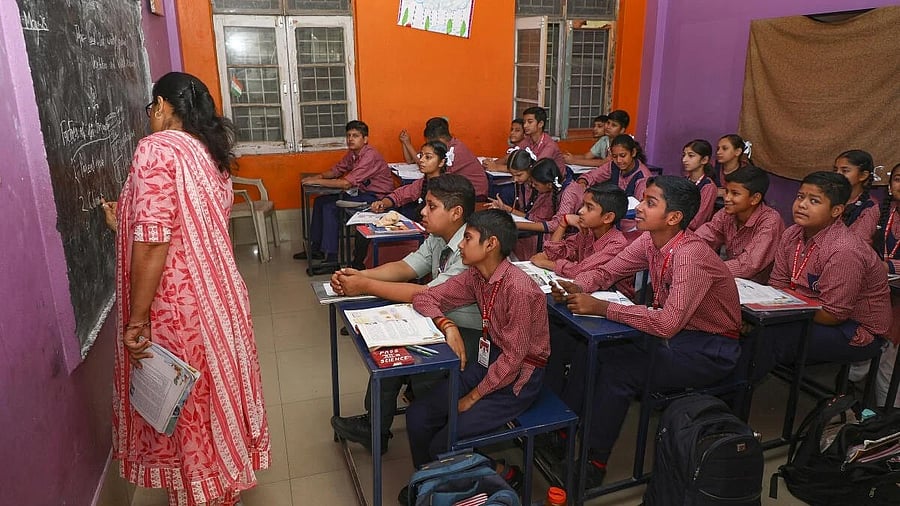
A representative photo
Credit: PTI File Photo
Kerala, which, along with Tamil Nadu and West Bengal, had long refused to sign a memorandum of understanding (MoU) for implementing the Centrally sponsored education scheme PM SHRI (PM Schools for Rising India), has made a U-turn.
The Central assistance of around Rs 1,500 crore is the justification being cited by the State Education Minister V Sivankutty for the change in the stand of the CPI(M)-led Left Democratic Front government's stand.
PM SHRI schools are designed to "showcase" the implementation of the National Education Policy (NEP) 2020, which Kerala has criticised from the outset, stating that it would pave the way for the BJP-RSS to impose their vested interests in the State's education sector.
The Centre has linked the release of funds under the Samagra Shiksha Abhiyan (SSA) to the implementation of PMSHRI. The SSA is funded by the Centre and the States in a 60:40 ratio.
The Union government has withheld the SSA funds due to Kerala since 2023-24, which, according to the Minister, cumulatively add up to Rs 1,500 crore.
While the Kerala government's decision has been criticised by the CPI, which is also part of the LDF, and by student and youth outfits, the Opposition Congress has sought to know if the upcoming local body and Assembly polls forced the CPI(M) to deviate from its political stand.
Tamil Nadu approaches SC
Tamil Nadu, which has not implemented the NEP and the PM SHRI, took the legal route to get the Right to Education (RTE) entitlements component under the SSA from the Centre. Earlier this month, the Union government released ₹538.39 crore under the RTE entitlements component to Tamil Nadu following a notice from the Supreme Court.
Meanwhile, differences still persist between the Centre and the West Bengal government over the former withholding the State's share of SSA funds.
What is PM SHRI scheme?
Launched in 2022, the PM SHRI scheme is a Centrally sponsored initiative aims to upgrade over 14,500 schools, managed by the Central government/State/Union Territory government/local bodies, including Kendriya Vidyalaya Sangathan and Navodaya Vidyalaya Samiti, to serve as model institutions showcasing the implementation of the National Education Policy (NEP) 2020. It runs for five years — from 2022–23 to 2026–27, after which the responsibility for maintenance lies with the respective States and UTs.
Key features of PM SHRI schools
Modern, well-equipped smart classrooms, computer labs, integrated science labs, vocational labs/skill labs and Atal Tinkering Labs.
Focus on competency-based learning.
Promotion of green initiatives such as water conservation, solar energy use, air/water/soil pollution, and waste management.
Experiential, inquiry-driven, and learner-centred pedagogy.
Cost of the scheme
The total cost of the project is Rs 27,360 crore spread over five years (Central share: Rs 18,128 crore and State share: Rs 9,232).
Funding pattern
60:40 between Centre and State governments and UTs with legislature.
90:10 between Centre and Northeastern and Himalayan States, Jammu and Kashmir.
100% Central funding for UTs without legislature
How are the schools selected?
Schools are selected for the PM SHRI scheme through a competitive 'challenge mode' wherein they compete for support to become exemplar schools. Selection is done through a three-stage process with definite timelines.
First, States and UTs sign an MoU with the Central government, laying down the commitments for supporting these schools.
Second, a pool of schools eligible to be selected is identified based on the prescribed minimum benchmark through the Unified District Information System for Education Plus (UDISE+) data.
The final stage is based on the challenge method, where schools must fulfil certain criteria, which are verified through physical inspection by States or other authorities. An expert committee, headed by the Secretary at the Ministry of Education, later makes the final selection.
Minimum benchmarks for schools to apply include:
The school should have its own pucca building in good condition.
Barrier-free access/ramp.
The school must be safety-oriented.
The enrolment of students at the elementary level and senior secondary class level must be more than the State average enrolment for the category.
The school should have at least one separate toilet each for boys and girls.
